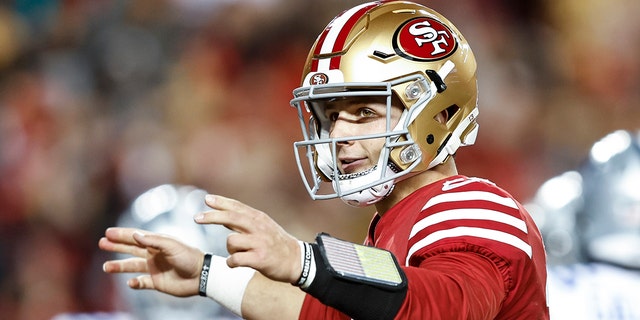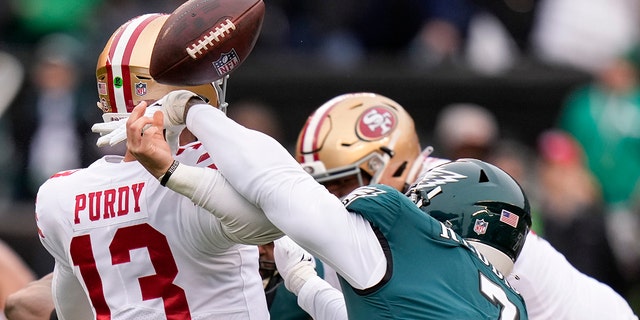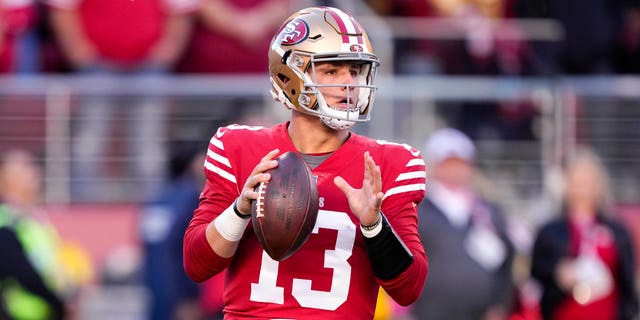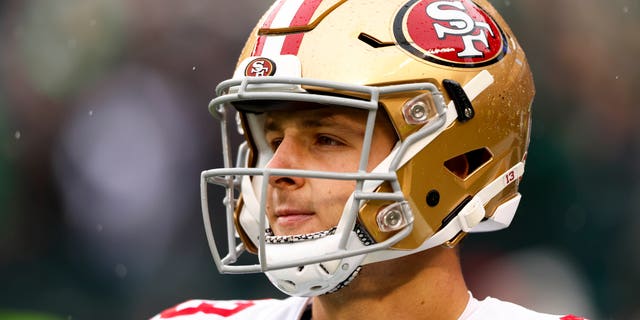49ers’ Brock Purdy could be ready for training camp with this UCL procedure, surgeon says
Since learning quarterback Brock Purdy had suffered a “complete tear” of the ulnar collateral ligament (UCL) in his throwing elbow, the San Francisco 49ers have been seeking second opinions to see what procedure should be done to get him back on the field.
Purdy’s injury, sustained during the Niners’ first drive of the NFC championship game against the Philadelphia Eagles, was the last thing head coach Kyle Shanahan and GM John Lynch wanted to see just one win away from a trip to the Super Bowl.
Now, their primary focus has shifted to whether Purdy, who replaced the injured Jimmy Garoppolo in Week 13 and went 7-0 before the loss to the Eagles, can be ready for training camp come August.
Dr. David Altchek, attending orthopedic surgeon and co-chief emeritus of the Hospital of Special Surgery Sports Medicine Institute in New York, specializes in the reconstruction of the UCL, better known as Tommy John surgery.
Altchek has performed surgery on some of MLB’s best, including the New York Yankees’ Luis Severino and the Los Angeles Dodgers’ Noah Syndergaard.
The 49ers don’t believe that a full reconstruction of the ligament is necessary, and Altchek agrees with their thinking.
BROCK PURDY SUFFERED ‘COMPLETE TEAR’ OF UCL IN NFC CHAMPIONSHIP LOSS TO EAGLES: REPORT
Speaking with Fox News Digital, Altchek explained the usual two options to repair the UCL. And he believes, despite not seeing an MRI, that Purdy’s situation calls for an alternative called an internal brace.
“The ways to fix it are classically to repair it and do a reconstruction with a tendon graft, and that’s what Tommy John surgery is,” Altchek explained. “The less invasive alternative is to repair it and supplement it with a synthetic ligament, which is called an internal brace.”
Lynch said Wednesday the team believes news from Purdy’s further assessments have him returning to the field at full strength in six months.

“I think the positive bit of news is that it seems to be consistent that the right approach is that one that takes about that six-month mark,” Lynch said. “Now, everybody will also say you never know until you get in there. Every surgeon will tell you that on every surgery, you always like getting in to see exactly. The MRI tells you a lot of the pictures, so they’re continuing to work through that process. But we seem encouraged by the prognosis that that’s kind of where it’s at.”
Altchek agreed with Lynch, saying whoever performs the surgery will clearly know the best course of action once the procedure begins. If the internal brace procedure is the answer, Altchek is certain six months will be the right timeline for Purdy, which makes him ready for training camp.
“It’s a good plan for him,” Altchek said. “It’ll work, and he’ll be able to return. I don’t think six months is out of the question. I really don’t.”
However, there is one discovery that could change the trajectory of Purdy’s surgery.
AARON RODGERS CROSSES ONE TEAM OFF LIST OF POTENTIAL OFFSEASON DESTINATIONS
“The tissue quality, you don’t really understand until you get in [the MRI]. So, if you tear the ligament in the middle, what’s called mid-substance, and you trash the tissue, a repair is really not going to work. Then, you might have to resort to some kind of reconstruction.”
Reconstruction, then, would mean Tommy John surgery, which normally has a recovery from nine to 12 months.

That surgery is normally synonymous with elite pitchers. It was named after Tommy John, who spent 26 years pitching in MLB for multiple teams. The reason you don’t hear it often with quarterbacks is because of the way the ball is thrown.
That’s the key for why Altchek has seen quarterbacks like former Cincinnati Bengal Carson Palmer in 2008 and even Buffalo Bills star Josh Allen this season be able to throw well after recovering from a UCL tear.
Of course, the severity of each tear is different, but the process for healing — and the throwing motion quarterbacks tend to use — normally leaves no long-term effects.
“The groundwork of quarterbacks versus pitchers — there was a really, really good study to show that the more lateral your release point, the further your hand is from the midline of your body, the more stress there is on the UCL,” Altchek said.
“When you think of a pitcher versus a quarterback, the quarterback has the football not that far from his ear when he throws no matter how far he reaches back. So his release point is much more medial and that puts a lot less stress on the UCL.
“The debate really is in baseball, not in football. I don’t see [Purdy] having any problems. I think he’s going to do great.”

In terms of rehab, Altchek says Purdy can likely start throwing about three months after surgery.
“They talk about starting to throw at like 10 weeks and then progressing in terms of effort and velocity up from 10 weeks to the six-month mark when they’re released to go unlimited,” he explained.
COWBOYS, 49ERS ARE ‘IN THE SAME BOAT’ WHEN IT COMES TO SUPER BOWL DROUGHTS, JERRY JONES ADMITS
So, if Purdy ends up going through with the internal brace procedure, San Francisco can breathe a sigh of relief knowing its potential starting quarterback could be ready for the start of training camp.
Trey Lance, who broke his ankle in Week 2 of the regular season, leading Garoppolo to take over, is their third overall pick from 2021. He should be ready for training camp as well, which will make for quite a competition.

Purdy finished the regular season with 1,374 yards and 13 touchdowns to four interceptions over five starts and nine games played. He also threw for three touchdowns and 332 yards in the wild-card round win over the Seattle Seahawks. He was 19 of 29 for 214 yards against the Dallas Cowboys in the divisional round.
Read the full article Here


